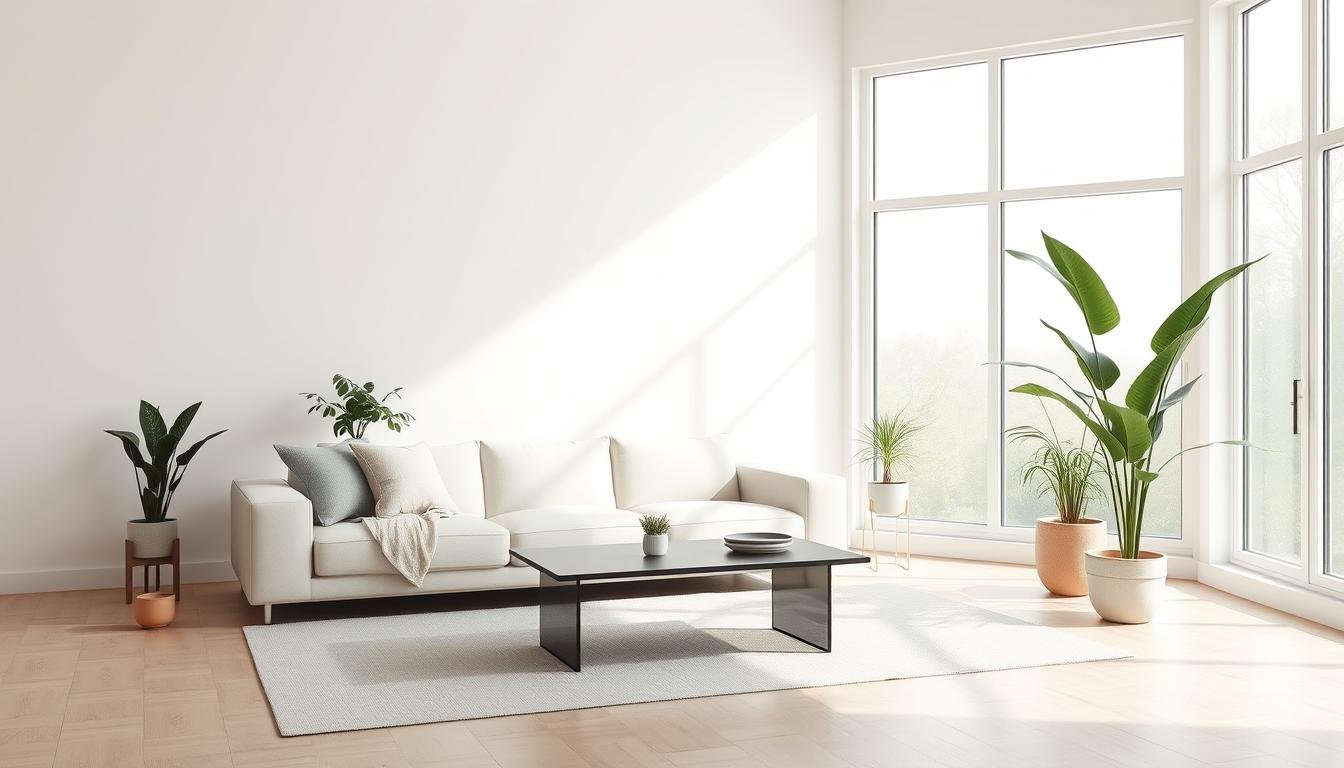Some links on this page are affiliate links. This means we may earn a commission at no additional cost to you if you click through and make a purchase. Thank you for your support!
Do you feel overwhelmed by clutter and dream of a peaceful, serene minimalist living room? You’re not alone. Many people are turning to minimalist design for a calm and simple living room. But how do you get this look? Let’s uncover the secrets to a minimalist living room that’s both serene and simple.
Understanding Minimalist Design Philosophy
Minimalist interior design focuses on simplicity, functionality, and the essentials. It uses neutral colors, open spaces, and furniture with clean lines. This design creates calm, uncluttered, and visually appealing living environments.
Benefits of Minimalist Living Spaces
Minimalist living offers many benefits. It makes spaces easy to maintain and clean. This reduces clutter and excess, promoting a calm and organized home.
The “Less is More” Approach
Minimalist design is all about quality over quantity. It chooses minimalist furniture for living rooms and living rooms with clean lines. Each piece has a purpose, adding to the overall look. Neutral colors bring harmony and balance to these spaces.
“Minimalism is not the lack of something. It’s the perfect amount of something.” – Nicholas Burroughs
Minimalist design encourages a thoughtful way of living. It combines minimalist lighting ideas and decluttered living room design for a serene space. Embracing this mindset creates a minimalist living room that looks good and works well.
Creating a Serene Minimalist Living Room
The minimalist design trend is still popular among homeowners. They want a living room that is both calm and functional. By choosing essential furniture, using natural light, and picking calm colors, you can make your living room a peaceful retreat.
Choosing the right furniture is key to a functional minimalist living room. Start with a comfy sofa, a useful coffee table, and maybe an armchair or two. This approach lets the scandinavian living room design principles show, where everything looks good and works well.
To make the room feel open and spacious, focus on your window treatments. Keep them simple so natural light can fill the room. This minimalist living room furniture layout makes the room bright and airy, adding to the calm atmosphere.
For colors, stick to a neutral palette. Use whites, creams, and soft pastels as the base. Then, add textures and materials like wood, stone, or natural fibers to warm up the space.
- Choose a minimalist furniture layout with essential pieces like a comfy sofa, practical coffee table, and accent chairs.
- Make sure windows are clear and use simple window treatments to let in natural light.
- Start with a neutral color palette, using whites, creams, and pastel hues.
- Add natural textures and materials like wood, stone, or natural fibers for depth and warmth.
- Go for an open floor plan to make the room feel bigger and more seamless.
By focusing on these elements, you can make a serene minimalist living room. It will be a calm and functional space. Minimalist design is all about creating a peaceful, stress-free area where you can relax and unwind.
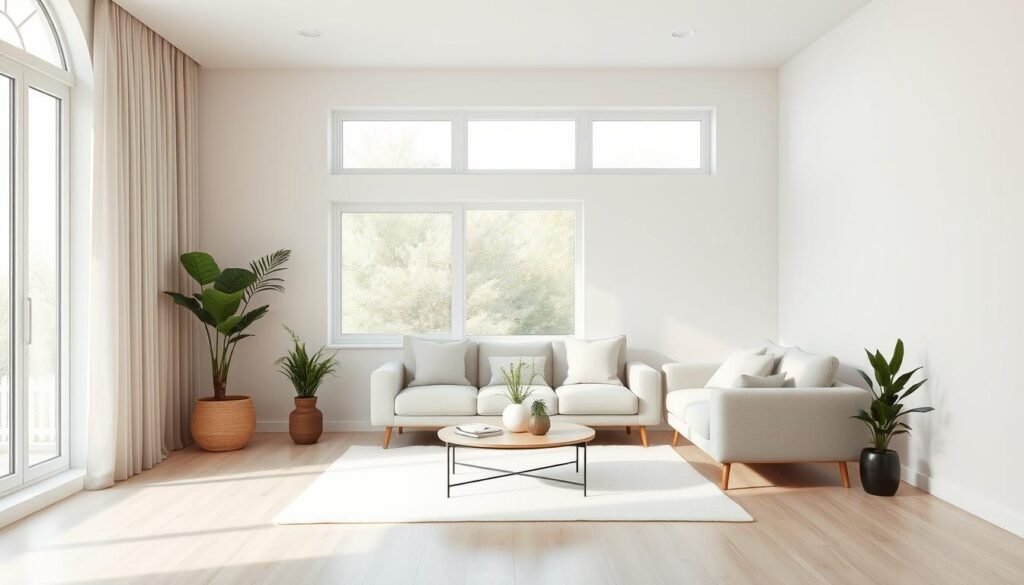
Essential Elements of Minimalist Color Palettes
Creating a serene minimalist living room starts with the color palette. Minimalist design focuses on clean lines, natural materials, and a simple color scheme. By understanding minimalist color palettes, you can make your living space a calm oasis of serene minimalist decor.
Working with Neutral Tones
Neutral colors are key in a minimalist palette. Designers recommend using three to five colors to keep things simple. Colors like white, black, gray, and beige offer a versatile base for your living room. They let other design elements stand out.
Incorporating Accent Colors
While neutrals are the mainstay, a touch of accent color can add depth. Soft pastels or rich jewel tones can be used in accessories, artwork, or furniture. This adds visual interest and prevents the space from feeling dull.
Creating Visual Balance
In a minimalist room, color and texture distribution is key. Designers suggest using monochromatic living room ideas for a cohesive look. Balancing neutrals and accent colors keeps the room calm and clutter-free, highlighting minimalist storage solutions.
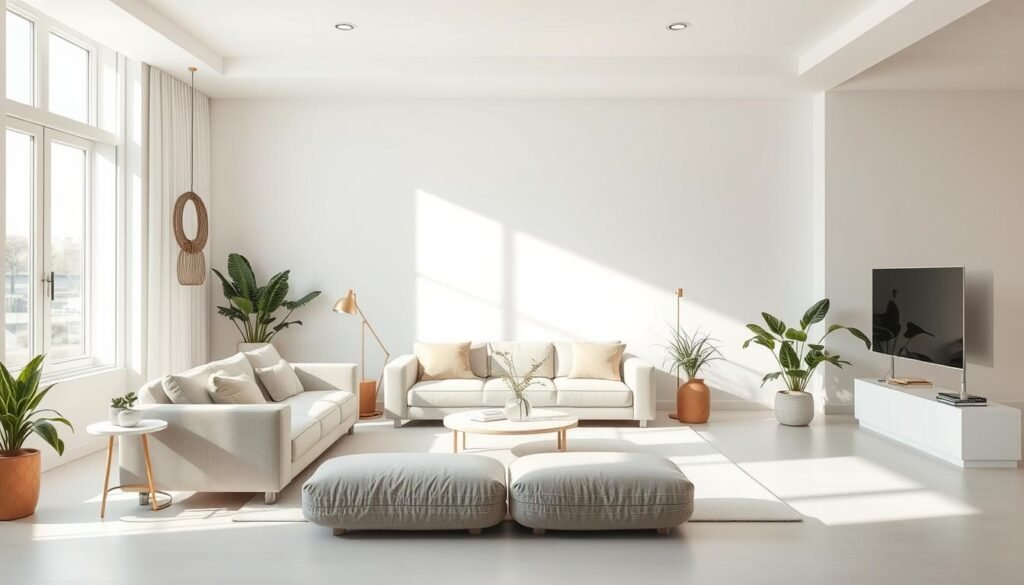
“The key to a successful minimalist color palette is to strike a balance between calming neutrals and thoughtfully placed pops of color. This creates a serene and visually interesting living space.”
By applying these color palette principles, you can create a living room that’s both tranquil and stylish. Minimalism’s beauty lies in its simplicity, letting natural materials and design elements shine.
Selecting the Right Minimalist Furniture
Choosing the right furniture is key to a cozy minimalist living room. Look for pieces with clean lines and simple shapes. They should have little to no extra details.
Choose furniture that does more than one thing. For example, ottomans with storage or coffee tables that can be used as desks. Adding quality wall decor and simple patterns can also help achieve the minimalist look. Popular choices include platform beds, sleek dining tables, and sofas with straight lines and neutral colors.
- Embrace clean, geometric forms that exude a sense of calm and simplicity.
- Prioritize pieces that seamlessly integrate into the open space living room design.
- Select furniture with a focus on functionality, ensuring every item serves a purpose.
- Opt for a neutral color palette, allowing the natural textures and materials to shine.
- Incorporate multifunctional furniture to maximize the use of space and maintain a clutter-free environment.
By carefully choosing your furniture, you can make a cozy and functional living room. It will show off the beauty of minimalist design.
“Simplicity is the ultimate sophistication.” – Leonardo da Vinci
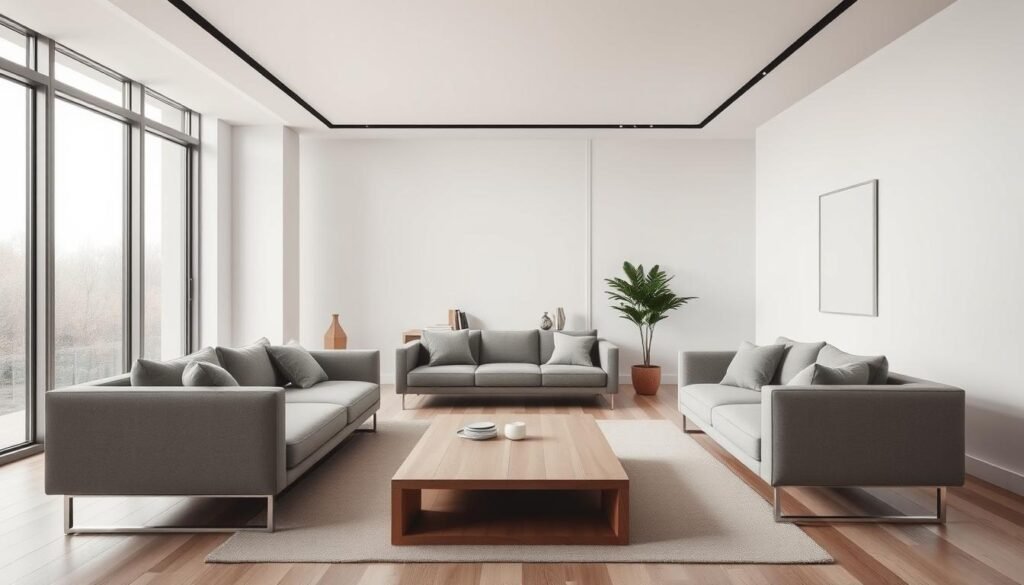
Remember, the secret to a great minimalist living room is finding furniture that looks good and works well. This will make your space feel calm and useful.
Maximizing Natural Light and Space
To create a calm minimalist living room, focus on natural light and space. Choose the right window treatments and arrange furniture wisely. This will bring openness and depth, making your space peaceful.
Window Treatment Strategies
Use sheer or lightweight window treatments to let light in. Avoid heavy curtains or blinds that block views. Instead, go for simple draperies or roller shades for easy light control.
Furniture Placement for Flow
Place furniture to keep paths clear and views open. Don’t block the room’s center with clutter. Use wall shelves or storage to keep floors free. Try different layouts to improve light and openness.
Creating Visual Depth
Use mirrors to reflect light and make spaces seem bigger. Add textures like rugs or throws for warmth. Plants or fresh flowers can also bring life to your room.
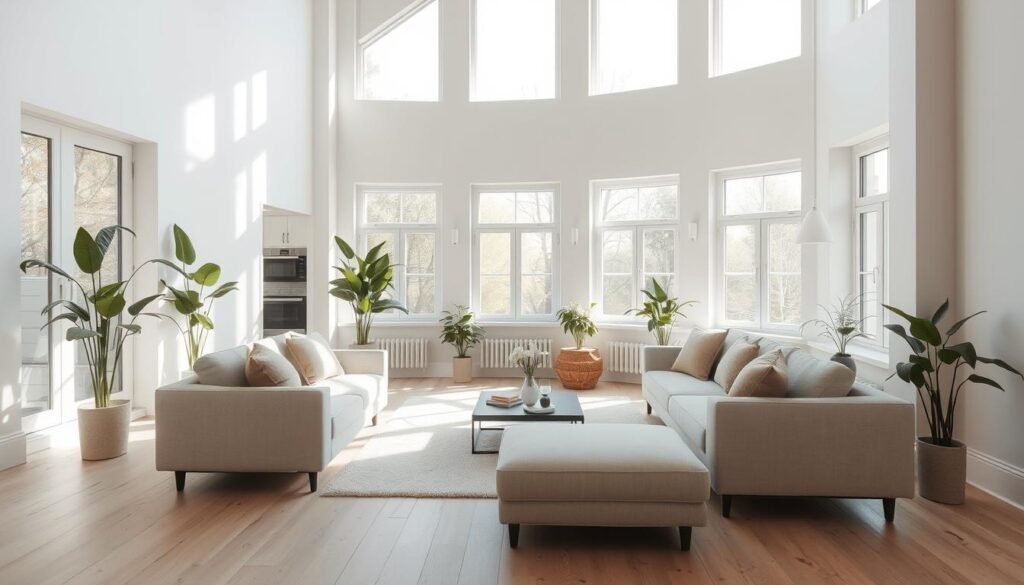
Mastering light, furniture, and depth can turn your minimalist room into a calm retreat. It’s a place for relaxation and refreshment.
Incorporating Natural Elements and Textures
To make a minimalist living room feel serene and inviting, use natural elements and textures. This approach brings warmth and depth. It celebrates the beauty of nature through carefully chosen materials.
Begin with natural wood tones, like a statement piece or a rustic wall. Add stone or ceramic accents for interest and a timeless feel. Indoor plants also bring the outdoors in, improving air and adding life to your minimalist living room.
Soft, natural textures like cotton, linen, or wool add to the room’s calm. Think about plush area rugs, knitted throw blankets, or textured wall art. They make your space cozy and inviting, keeping the clean and simple living room design intact.
Pair smooth surfaces with these touchable elements for a minimalist living room accents that feels warm. The mix of muted tones and soft textures in your minimalist design creates a peaceful space that soothes the senses.
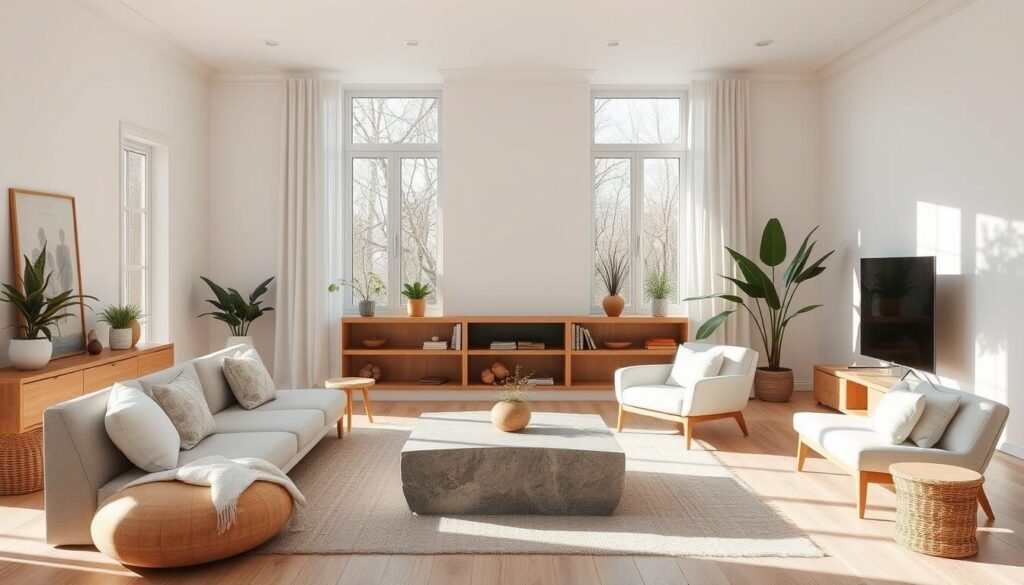
“The key to creating a serene minimalist living room is finding the perfect balance between clean lines and natural, tactile elements.”
By carefully adding natural elements and textures, you can make a minimalist living room that’s warm, comfortable, and visually appealing. It stays true to the clean and simple living room design spirit.
Storage Solutions for Clutter-Free Living
To have a calm and simple living room, you need more than just good looks. You also need smart storage solutions. These help keep your space tidy and peaceful. With clever storage and organization, your minimalist living room layouts will stay beautiful and organized.
Hidden Storage Ideas
Make the most of your living room with statement art with hidden storage. Look for furniture with secret spots, like simple sofa designs for living rooms with storage ottomans. Also, consider wall shelves and cabinets for books and decor without messing up your neutral living room palettes.
ALSO READ: When and How to Declutter for a Minimalist Home
Multi-functional Furniture Selection
Choosing furniture that does more than one thing is key in a minimalist living room for small spaces. Find items like TV stands with drawers or sideboards with hidden spots. These pieces help keep your space tidy while keeping essentials close.
Organizational Systems
Set up systems to keep your living room clean. Use storage boxes, baskets, and trays for small items like remotes and magazines. Regularly getting rid of things you don’t need helps keep your space calm. Also, make cleaning and tidying a regular part of your routine.
By using smart storage, multi-functional furniture, and good organization, you can have a minimalist living room that looks great and works well. Minimalism helps you create a peaceful and organized home.
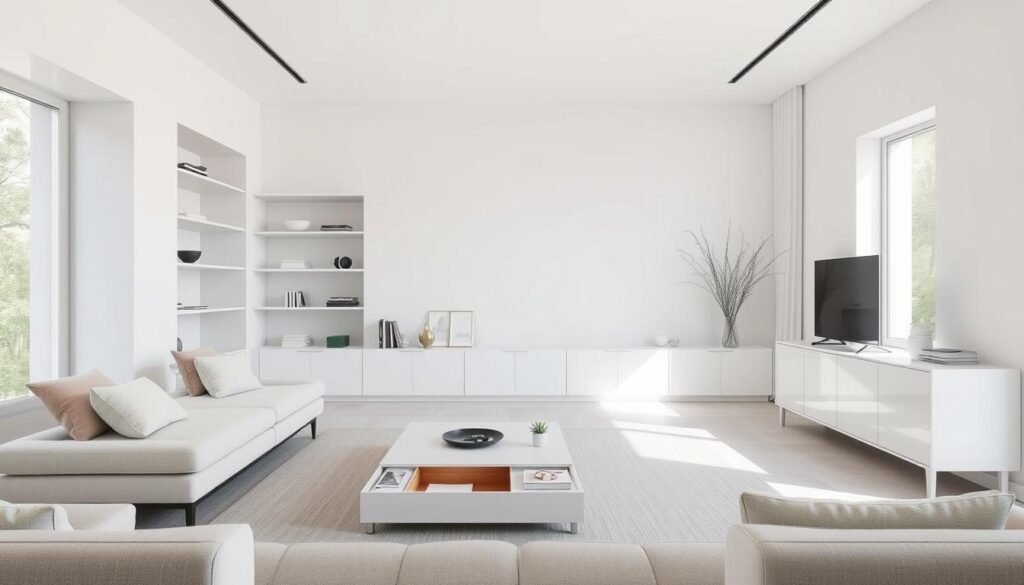
Minimalist Lighting Design Strategies
Creating a calm minimalist living room starts with smart lighting. Make sure windows are clear to let in natural light. This adds warmth and coziness to the room.
For artificial light, pick sleek, modern fixtures. Look for simple shapes and finishes like chrome or matte black. Stay away from fancy lights that mess up the room’s clean look.
Think about lights that can change the mood. Floor lamps add warmth and save space. Hidden LED strips provide soft, ambient light, making the room feel peaceful and organized.
With the right lighting, your minimalist living room will shine. It will be both beautiful and calming, thanks to its clean lines and natural light.
ALSO READ: Summer Backyard Decor Tips for a Vibrant Look
Frequently Asked Questions
What are the core principles of minimalist design?
Minimalist design focuses on simplicity and functionality. It uses only the essential elements. This creates a clean and visually appealing space.
What are the benefits of minimalist living spaces?
Minimalist spaces offer more room and less stress. They are easy to maintain and look timeless. This design style values quality over quantity, making spaces calm.
How can I create a serene minimalist living room?
For a calm minimalist room, pick essential furniture and use natural light. Stick to a neutral color palette and add natural textures. Open floor plans and smart storage keep it clutter-free.
What color palettes work well in a minimalist living room?
Neutral colors like white, beige, gray, and black are key. They provide a calm base. Use accent colors sparingly through accessories or furniture.
What type of furniture should I choose for a minimalist living room?
Opt for furniture with clean lines and simple shapes. Choose pieces that serve a purpose and add to the room’s functionality. Multifunctional items like ottomans with storage are great.
How can I maximize natural light and space in a minimalist living room?
Use sheer window treatments and arrange furniture for clear paths. Mirrors can reflect light and make the room feel larger. Floating shelves are better than bulky cabinets.
What natural elements and textures can I incorporate into a minimalist living room?
Add warmth with wood, stone, or plants. Use materials like cotton or wool for softness. Add interest with rugs, blankets, or wall art without cluttering.
How can I incorporate storage solutions in a minimalist living room?
Use built-in shelving, hidden storage ottomans, or storage coffee tables. Choose furniture with built-in storage. Organize regularly to keep the space clutter-free.
What lighting design strategies work best in a minimalist living room?
Keep windows clear for natural light. Choose sleek, modern lighting fixtures. Use finishes like chrome or matte black. Adjustable lighting and hidden LED strips add ambiance.

